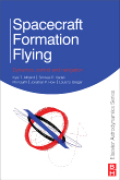
Spacecraft formation flying (SFF) is of huge importance to the aerospace and space community. Not the stuff of science-fiction, SFF involves flying multiple small satellites together, to deliver benefits which far outweigh a single larger craft or space station. The first autonomous formation flying earth science mission was in 196 and NASA now has 35 SFF mission sets. By networking several smaller and cheaper craft, scientists can make simultaneous measurements that enable higher resolution astronomical imagery, provide robust and fault-tolerant spacecraft system architectures, and enable complex earth science and space science networks dispersed over clusters of satellites in space. This isthe first book to introduce and explore SFF. It is a topic of enormous importance to aerospace engineers, astrodynamicists, satellite engineers, astronomers, physicists, and applied mathematicions. This book provides a complete introduction to the subject and is supported by graduate level student exercises plus Matlab and Maple code sets for running SFF simulations. * The first book dedicated to spacecraft formation flying which is the enabling element of distributed spacecraft systems.* Written by the leading researchers and teachers in the field; perfect for research and graduate students. * Accompanied by Matlaband Maple code sets and exercises for graduate level students of aerospace science, astrodynamics and orbital mechanics
- ISBN: 978-0-7506-8533-7
- Editorial: Butterworth-Heinemann
- Encuadernacion: Cartoné
- Páginas: 382
- Fecha Publicación: 01/12/2009
- Nº Volúmenes: 1
- Idioma: Inglés
